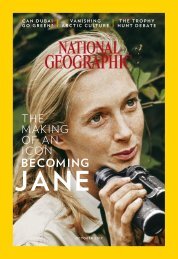NC
You also want an ePaper? Increase the reach of your titles
YUMPU automatically turns print PDFs into web optimized ePapers that Google loves.
BY ROBERT KUNZIG<br />
PHOTOGRAPHS BY LUCA LOCATELLI<br />
T<br />
o plunge headlong into the<br />
audacity of Dubai—the sprawling<br />
efflorescence of concrete, glass,<br />
and steel that has sprung up over<br />
the past three decades on the<br />
scorched sands of Arabia—you could start by<br />
going skiing. From outside the Mall of the<br />
Emirates, the slope looks like a silver spaceship<br />
impaled in the ground floor. Inside you<br />
can window-shop at Prada, Dior, and Alexander<br />
McQueen before pushing through the glass<br />
doors of Ski Dubai. Passing a mural of the Alps,<br />
you zip up your parka, pull on your gloves—and<br />
marvel at what air-conditioning can do.<br />
The souvenir T-shirt I bought bears a cartoon<br />
of a Celsius thermometer. “I went from +50 to -8,”<br />
it announces. It didn’t feel quite that cold on the<br />
slope, but the temperature outside in Dubai can<br />
get close to 50 (122°F) in summer. The humidity is<br />
stifling then because of the proximity of the sea.<br />
Yet it rarely rains; Dubai gets less than four inches<br />
a year. There are no permanent rivers. There is<br />
next to no soil suitable for growing crops.<br />
What kind of human settlement makes sense<br />
in such a place? For centuries Dubai was a fishing<br />
village and trading port, small and poor. Then<br />
oil and a wild real estate boom transformed it<br />
into a city that sports a skyline of architectural<br />
wonders and the world’s third busiest airport.<br />
“From the point of view of sustainability, you<br />
probably wouldn’t have done it here,” says Janus<br />
Rostock, a prominent architect transplanted<br />
from Copenhagen.<br />
And yet a sustainable city is precisely what<br />
Dubai’s government now says it aims to create.<br />
Sustainable? Dubai? When camels fly, you<br />
might say. The boom years made the city a poster<br />
child for the excess that results when cheap energy<br />
meets environmental indifference. Indoor<br />
<br />
<br />
<br />
skiing is just a symbol: Dubai burns far more fossil<br />
fuel to air-condition its towers of glass. To keep the<br />
taps running in all those buildings, it essentially<br />
boils hundreds of Olympic pools’ worth of seawater<br />
every day. And to create more beachfront for<br />
more luxury hotels and villas, it has buried coral<br />
reefs under immense artificial islands.<br />
In 2006 the World Wildlife Fund (WWF) declared<br />
the United Arab Emirates the country with<br />
the largest ecological footprint per capita, largely<br />
because of its carbon emissions. The shoe certainly<br />
fit Dubai, the most conspicuous consumer<br />
among the nation’s seven emirates. In the decade<br />
56 NATIONAL GEOGRAPHIC • OCTOBER 2017



